Civil Rights and the Blues:
Where 2 Theatre Companies Found Their Voices
Inspired by the Federal Theatre Project and the Black Arts Movement, the New Lafayette Theatre and New Federal Theatre were hubs of both art and activism.
By Hinton Battle, Dr. Dorothy Marcic, & Kimberley Lamarque Orman
This is the third in an ongoing series, the Tapestry of American Black Theatre, which is chronicling the too often forgotten contributions of Black theatremakers in the U.S. Future articles will explore some of the many Black Theatre organizations, leaders, performers, and work. There are currently nearly 90 Black theatres in the United States.
Originally published in American Theatre, January 12, 2022
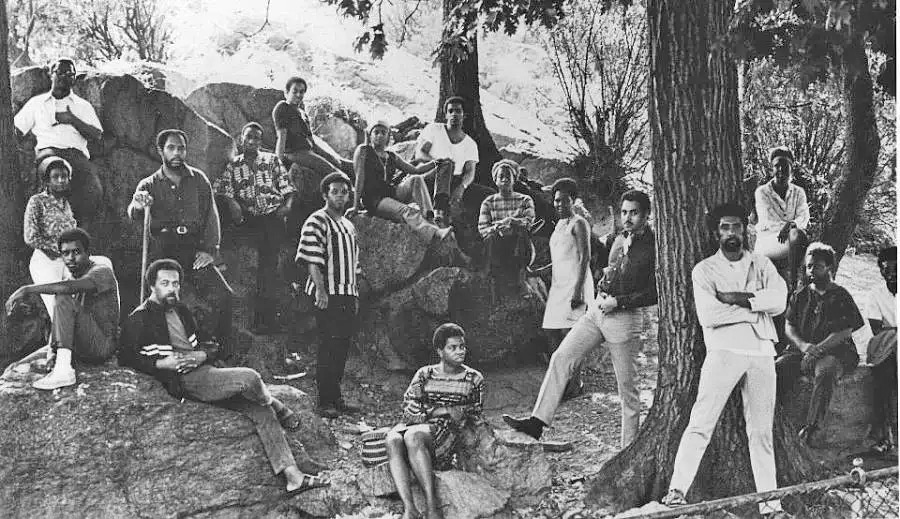
Members of the New Lafayette Theatre.
On the dark day in 1965 when Malcolm X was murdered in Harlem, actor Robert Macbeth was just 20 blocks away, teaching acting classes. After the events of that day he realized: This was the time to move forward. Though he’d studied with the famous Lee Strasberg and landed many roles on Broadway, in films, and on TV, he’d begun to feel that his work paled in comparison to the urgency of the Civil Rights struggles in the South, from lunch counter sit-ins to church bombings. He yearned to make a meaningful contribution to his people’s fight for justice and freedom, and to provide dramatic presentation examining their persistence, capabilities, and need for self-defense, and to create stage work that echoed the improvisatory art of such jazz icons as Miles Davis and John Coltrane.
But at that point there was no way for Black theatre artists to do that kind of work in mainstream, white-run theatres, at least not in enough numbers to make a difference. (And it would be another year before Douglas Turner Ward penned the New York Times editorial that led to the founding of Negro Ensemble Company.) So to do what he wanted to do, and have the impact he hoped to have, Macbeth knew he would have to create his own organization.
He thought back to a picture he’d seen in a book in Strasberg’s library about the Federal Theatre Project’s 1936 production of Macbeth with an all-Black cast, set in the Caribbean. Directed by a then 20-year-old Orson Welles, the play was popularly called Voodoo Macbeth, and over 10,000 people crowded the Harlem streets around the Lafayette Theatre, packing 7th Avenue for 10 blocks. The photo of the event showed the marquee with the words “Lafayette” and “Macbeth” both prominently legible—a convergence that the fortuitously named Robert Macbeth remembered when he was ready to start his own company. He would call it the New Lafayette Theatre.
Thinking ahead, he knew he would have to attract attention and build an audience. He needed controversial and dynamic plays, and he found one in Ed Bullins’s Goin’ a Buffalo. Written in a lyrical, cool-jazz style and set in the street-hustler world of L.A.’s Sunset Strip, it featured people and speech not typically considered acceptable for general audiences: nihilistic pimps, whores, dealers and users, speaking in profane “gutter talk.” He knew he couldn’t open his new venture with this easily misunderstood work, so Bullins offered him In the Wine Time, in which the characters weren’t quite as edgy but the language certainly was. “Sho’ u’m bad, hon-nee chile,” goes one speech. “U’m forty hands across mah ches’…Don’t fear nuthin’…not God nor death. I got a tombstone min’ an’ a graveyard disposition…U’m a bad mutha-fukkah an’ I don’ min’ dyin’.” This dialogue reminded Macbeth of athletes he had encountered in pick-up basketball games—men of courage who had overcome odds most never face, and who welcomed physical competition without animosity.
Though neither Bullins play would open the New Lafayette Theatre (NLT) in 1967, Bullins was enthusiastically on board from the jump, regularly attending the actors workshop, attending rehearsals, taking tickets, passing out programs, and typing office materials. Bullins had been involved in Oakland with the Black Panthers as the party’s cultural liaison, and he brought both competence and a spirit of change with him. Bullins and Macbeth considered themselves enemies of the state and the status quo—of the violence and injustice in Mississippi, Ala., as well as in South Africa and worldwide. As Bullins remarked, “Art is a good disguise.”
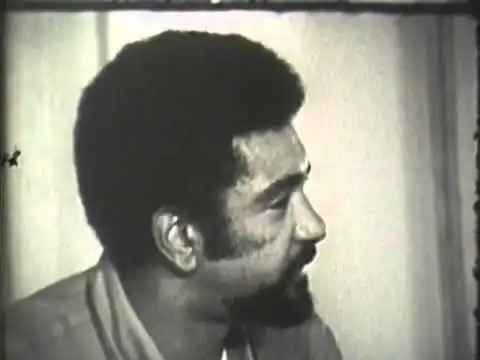
Robert Macbeth.
It was with funding from the Rockefeller and Ford Foundations that Macbeth started his new theatre, securing and renovating the same building on 132nd Street and 7th Avenue as the original Lafayette Theatre. The company included Macbeth as director; Bullins as playwright-in-residence; Richard Wesley as editor of their Black Theatre Magazine (which connected them with Black theatres in the South and West); and Roscoe Orman as a writer for the magazine and frequent actor in their plays and films. Other company members included Estelle Evans, Gary Bolling, George Miles, Sonny Jim Gaines, Whitman Mayo, and Helen Ellis.
The NLT’s youngest member was Karen Baxter, who loved being around theatre so much that she did everything they needed, from stage managing to costume-sewing and set painting, from writing and photocopying the programs to sweeping the stage and ultimately running the box office. Her greatest joy, Baxter recalled, was “standing in the back of the theatre as the lights went down, watching actors enter on cue in perfect costumes, having the green door open when it should—all those things I was directly involved in, watching them come together and work. It was magic.” Baxter went on to direct Brown University’s Rites and Reason Theatre for 22 years, during which time she produced countless plays, including the innovative interactive play Heart to Heart: Is Your Life Worth Saving?
Richard Wesley, who was also a playwright, had formative experiences in the NLT writing workshops led by Bullins. Wesley had started out at Howard University with aspirations of writing for television, but his first semester there rocked him: He had barely arrived on campus in the fall of 1963 when the Birmingham church bombing occurred; one of the four Black girls murdered in that atrocity was close to a new college friend of Wesley’s. Then he met Stokely Carmichael, who was involved as a voting rights organizer in Mississippi and Alabama. Two months later, President Kennedy was assassinated, and Wesley solemnly walked by the casket in his ROTC uniform. During his second semester Berkeley’s Free Speech movement started, supported by the Congress of Racial Equality (CORE) and the Student Non-Violent Coordinating Committee (SNCC).
Howard closed its screenwriting program, and Wesley moved to playwriting at an auspicious time. Not long after that, Dutchman, a play by LeRoi Jones (later Amiri Baraka), debuted in New York and sent shock waves through the culture. In March 1965, Howard’s theatre chair, Owen Dodson, brought the play to the university. Coming on the heels of their mounting of James Baldwin’s Blues for Mr. Charlie (loosely inspired by the lynching of Emmett Till), Howard’s staging of Dutchman showed Wesley the power of theatre to bring social change. Perhaps he could do more than write episodes for The Twilight Zone.
As he walked among buildings at Howard named named after Black heroes—the developer of blood plasma, Charles Drew, or Alain LeRoy Locke, the Harlem Renaissance’s intellectual founder, or Thurgood Marshall, the superstar lawyer who would soon be appointed a Supreme Court justice—Wesley saw the need for strong Black leaders in the arts as well. Realizing that theatre could be a positive force for change, he was influenced by the Mao quote, “An army without culture is a dull-witted army, and a dull-witted army cannot defeat the enemy.”
In Bullins’s classes, Wesley found a home with like-minded souls and went on to write such plays as Black Terror, The Past Is the Past, and The Talented Tenth, and such films as Uptown Saturday Night and Let’s Do It Again.
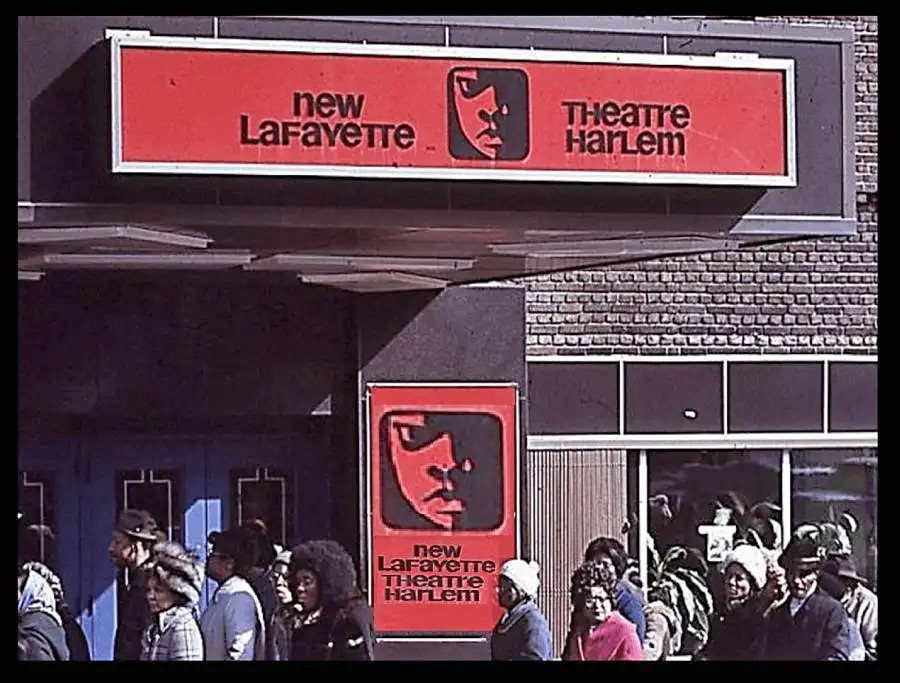
The vision for the New Lafayette was to have plays by and for Black folks, about Black life, in Black vernacular. As Macbeth later noted, “Our job has always been to show Black people who they are, where they are, and what condition they live in.” Their first experimental plays were hits. Ron Milner’s Who’s Got His Own (a phrase taken from the Billie Holiday standard “God Bless the Child”), which dealt with Black masculinity and father-son conflict, opened October 1967. The theatre’s second was Blood Knot, a two-hander by the white South African playwright Athol Fugard, about two brothers with the same Black mother but different fathers, one white and one Black.
Tragedy struck six months into the NLT’s existence: On Jan. 31, 1968, Macbeth and Bullins watched as their recently renovated building burned to the ground. Though charges were never filed, everyone at New Lafayette believed it was arson. It would be a tough year all around: Martin Luther King Jr. was murdered in April, with riots following around the country, including Harlem; in June, presidential candidate Robert F. Kennedy was gunned down. Protesters were beaten and jailed, including at the Democratic convention in Chicago, and while the Vietnam War raged on, Richard Nixon was elected president.
While the theatre was being rebuilt, the NLT produced their work at American Place Theatre on West 46th Street (currently Theatre at St. Clements). And by the end of 1968, the rebuilt theatre was host to Bullins’s In the Wine Time. Lindsay Patterson, a Black theatre scholar, wrote in The New York Times that he was pleased to see a show about Blacks without a trace of “whitey” around—a play which, even so, by “present[ing] a slice of Black life as it is actually lived…turns out to be a far more serious indictment of white society than any polemic on the subject.” The next production was Bullins’s We Righteous Bombers, a theatre-of-the-absurd parody of would-be revolutionaries for which he used the pseudonym Kingsley Bass Jr. (The pen name may have been a wise move, as the real-life revolutionaries of the day were not amused; Macbeth held a symposium with the leading protest voices participating.)
In response to criticisms like this, Macbeth changed course and went down a different theatrical path, toward a kind ritual theatre, a pursuit made popular by many Black Studies programs, and which evoked Mother Africa through stories, costumes, and masks.
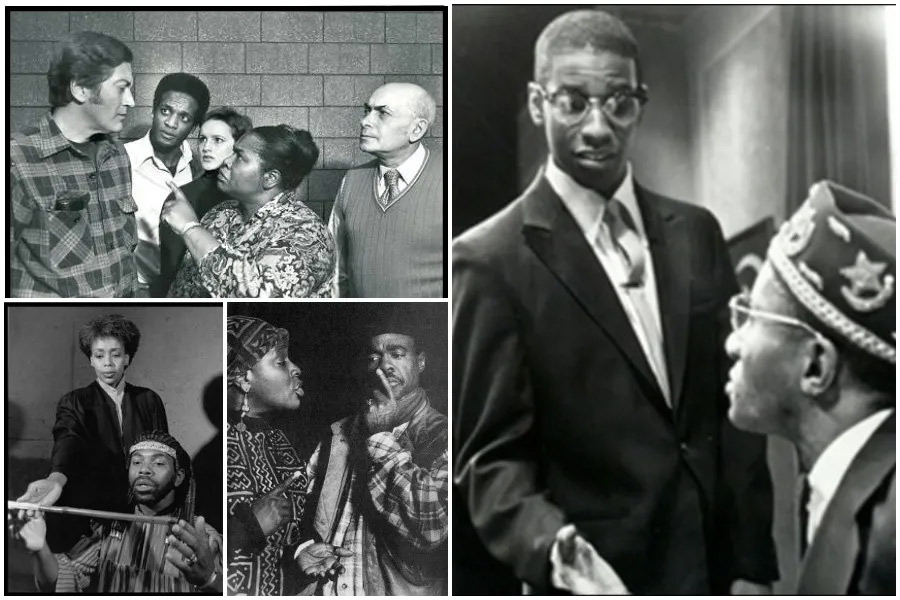
New Federal Theatre productions, clockwise from top left: John Lemley, Carl Crudup, Terria Joseph, Theresa Merritt, and Hy Mencher in “Trouble in Mind,” 1979 (photo by Bert Andrews); Denzel Washington and Kirk Kirksey in “When the Chickens Came Home to Roost,” 1981; Ebony Jo Ann & Glynn Turman in “Do Lord Remember Me,” 1976; Angela Sargeant and Andre De Shields in “The Sovereign State of Boogedy-Boogedy,” 1986 (photo by Bert Andrews)
With political changes during the Nixon administration, federal grants to community and arts organizations drying up, and foundation funding ending, NLT was forced to close its doors in late 1972. Meanwhile, another Black theatre inspired by the legacy of the Federal Theatre Project had recently found its footing, and would take up some of the same artists and aesthetics of its predecessor. In 1970, Woodie King Jr. started the New Federal Theatre as an outgrowth of the Mobilization for Youth Program, funded by both the Henry Street Settlement and the New York State Council of Arts.
A Detroit native, King took music as his inspiration, setting out to capture the energy and emotion of the blues music in theatrical form. He initially started Concept East Theatre in Detroit, not long after Motown Records formed there, and his thought-provoking and engaging plays garnered a lot of attention. One ended up on tour in New York City, where he got offered a job at age 25 to run the Mobilization for Youth (MFY) program, with a budget of a million dollars, to teach theatre, dance, and film to the city’s under-resourced minorities. MFY became one of the most successful anti-poverty programs, introducing the students to major artists, like Otto Preminger and Angela Lansbury, and taking them to festivals everywhere from Texas to Rome. Students got jobs with Negro Ensemble Company, among other places.
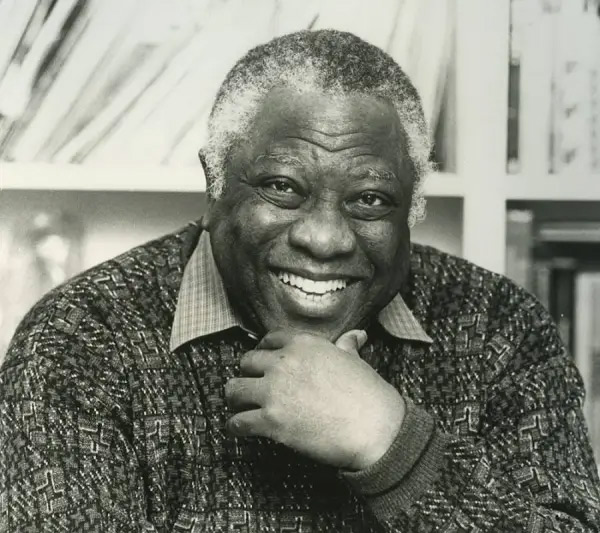
Woodie King Jr.
King wanted to do more than train young people, though. With NFT, his goal was to integrate women and people of color into theatre. In the early years, they did revivals of plays originally produced by the Federal Theatre Project of the 1930s, such as Macbeth and Hughes Allison’s The Trial of Dr. Beck, followed by Suddenly Last Summer, a production so well-received that even its author, Tennessee Williams, came to see it.
NFT did five to six plays a year. And while other theatres fell prey to funding shortfalls, King and his team constantly problem-solved and fund-raised in endless calls and meetings with possible donors, even those giving as little as $50, and continuous networking with writers, actors, producers, filmmakers, tour directors, and other Black theatres—all the while seeking out exciting original work for their stage that would make it all worthwhile.
NFT became a developer of talent. Four months before his breakout Off-Broadway turn in NEC’s A Soldier’s Play, Denzel Washington played Malcolm X in Laurence Holder’s When the Chickens Come Home to Roost, which opened June 1981 at NFT. In the audience was Spike Lee, who 10 years later would cast Denzel in the film Malcolm X.
Other exposure boosters for NFT included J.e. Franklin’s Black Girl, whose title character defies expectations to become a dancer, and which was made into a feature film by Ossie Davis, starring a young Leslie Uggams. Other famous names who cut their teeth onstage at NFT: In 1975, 16-year-old Laurence Fishburne appeared in Section D. The following year Debbie Allen’s choreography for Mondongo helped land her a role on the TV sitcom Good Times. In 1981, Phylicia Allen (later Rashad) starred in Zora, based on the life of novelist Zora Neale Hurston. And as late as 2002, Chadwick Boseman won an AUDELCO award for his turn in Ron Milner’s Urban Transition.
NFT also found a home for a memorable play by Ed Bullins, The Taking of Miss Janie, about race relations and rape, which won the New York Drama Critics Circle citation for Best American Play in 1974—the first Black play to be so honored. It was produced at the Public Theater the following year. The relationship with the Public also led to the triumph of Ntozake’s Shange’s for colored girls who have considered suicide/when the rainbow is enuf, a series of monologues and choreopoems from seven female characters oppressed by racism and sexism, weaving stories of love, betrayal, and struggle into a loose sisterhood. Originally produced by NFT, it went onto a production at the Public and on Broadway (it is slated for a revival there in March).
While some other Black theatres in New York rose and fell on the vicissitudes of funding, the NFT outlasted most of them, putting up a total of 450 mainstage productions while weathering changing values in the culture, national financial collapses, and a shifting political landscape. King’s leadership has been crucial throughout.
“We have to redefine what art is, because it has become mostly intellectual, without passion,” he said. Young people need a burning desire to enter the theatre field, where success is not assured. “Everyone has obstacles,” he said. “So it’s a matter of how much you want it, and how hard you’ll work to get there.”
###
Hinton Battle is a three-time Tony winner whose Broadway credits include The Wiz, Bob Fosse’s Dancin’, Dreamgirls, Sophisticated Ladies, Chicago, Miss Saigon, and The Tap Dance Kid. He is currently the co-founder and director of the Hinton Battle Dance Academy (HBDA) in Tokyo.
Dorothy Marcic, Ph.D., is a Columbia University professor, Fulbright Scholar, and playwright of Respect: The Musical and Sistas: The Musical. She’s the writer of 21 bestselling books and award-winning screenplays, and is co-creator of the Wondery podcast “Man-Slaughter.”
Kimberley LaMarque Orman, a professor at Fordham University and executive producer of the video series Fordham Road, has produced, acted, and directed in a variety of productions across the U.S., including Joe Turner’s Come and Gone, Jar the Floor, Macbeth, In the Blood, Blues for an Alabama Sky, Romeo & Juliet, Three Sisters, Ma Rainey’s Black Bottom, and The Old Settler.

